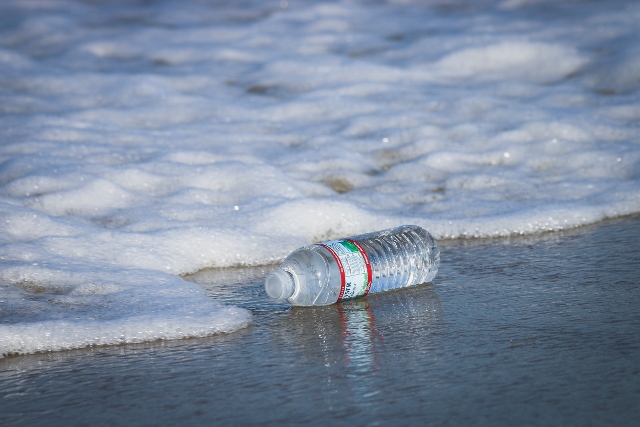If I asked you to tie an overhand knot, you might stumble a bit. Actually, if you’ve never been a scout, you might think it’s impossible for you to know how to tie such an obscure knot.
But what if I showed you an example?
It would certainly help, right? Check out the video below to learn how to tie an overhand knot.
I’m pretty sure that most of you have tied this knot more than once in your lifetime. But as the video states, you simply didn’t know the official name of the knot you were tying.
So. What does tying knots have to do with writing a persuasive speech?
Admittedly, not much. But it does illustrate that sometimes you have a pretty good sense of how to do something, even if you don’t realize it. You just need an example to remind you how it’s done and to get you moving in the right direction.
That’s exactly the goal of this post: to provide you with two persuasive speech examples that can inspire your own writing.

2 Good Persuasive Speech Examples to Inspire You
In the two speeches below, I’ve included comments on what makes these examples good. I’ve also made note of a few places where the speaker may improve.
TAKE NOTE: Both of these speeches cite sources. If you’re required to turn in your outline or a copy of your speech, check with your teacher (or assignment guidelines) to see if you should include a Works Cited (MLA), a list of references (APA), or a bibliography (Chicago).
For both persuasive speeches, my commentary is marked with “Susan says” speech bubbles. The specific text that I’m discussing from each speech is notated with brackets and corresponding numbers—[#]. For commentary that applies to full paragraphs, you’ll see the following notation at the end of the paragraph(s): *[#].
Persuasive Speech Example #1: A Persuasive Speech on Limiting the Production and Use of Plastic

A Persuasive Speech on Limiting the Production and Use of Plastic
[1] When you hear the term “polluted plastics” I can tell you the exact picture that just popped into about 10 of your heads. This one, right? You have all heard of how plastics are affecting our marine life and “oh, the poor sea turtle”. And that’s great! Really, it is. We have had the idea that “pollution is bad” drilled into our brains since we were about 7. But this little sea turtle is not necessarily the problem. It’s much bigger than him. Plastics are leaving lasting effects on our ecosystems due to the improper disposal. Plastic production also uses up many of our natural resources. It is up to us to make a change in order to maintain sustainability. [2] Today, I want to show you just how destructive these effects are, how big of a dent we are making in our natural resources, and what steps we should take next.
Susan says:
[1] This opening uses an excellent hook to grab the attention of the audience. The speaker uses the common image of a sea turtle being affected by pollution to make a connection with the audience and get them thinking about how pollution affects the environment.
Susan says:
[2] The speaker ends the opening with a clear thesis statement to let the audience know that the speech isn’t just about sea turtles. The speech will discuss the environmental impact of plastics and how to reduce the use of plastics.
Remember, a thesis statement is like a roadmap to your entire speech, so make sure to include a focused thesis to let your audience know what to expect.
Let’s say you want to throw away one plastic water bottle. Okay, no big deal. It’s just one bottle right? Well, Charleston is a peninsula, meaning that we are entirely surrounded by the ocean. According to Hannah Ellsbury in her article “The Problem with Plastic”, for every six water bottles we use, only one makes it to the recycling bin. The rest are sent to landfills. Or, even worse, they end up as trash on the land and in rivers, lakes, and the ocean. That means that, on average, all of us in this room cumulatively throw away or litter 6,100 water bottles a year. Now, let’s say that about ¼ of these end up in our beautiful Charleston harbor. That’s about 1,525 bottles just floating around outside of Charleston in a year, and that’s strictly from our first year seminar class alone. Pollutants found in the plastic in disposable water bottles deteriorate and leach into the water leaving potential carcinogens in the water we drink daily. Now if all 1,525 water bottles in our harbor are deteriorating, that means your fresh seafood at Hyman’s might be slightly infested with pollutants. *[3]
Susan says:
*[3] Most people use (or have used) plastic water bottles. The speaker knows this and thus uses this example to make another connection with the audience.
The speaker even goes one step further by mentioning the effects of pollution on seafood at a local restaurant.
Using these types of personal and localized examples are excellent ways to convince your audience because the audience can directly relate and see how pollution affects their daily lives.
This section also cites statistics and other information from sources to provide evidence of the claim. Such information further convinces the audience because they realize that the speaker isn’t simply providing a personal opinion. Instead, statements are backed up by experts.
[4] Even worse, according to the Merriam Webster dictionary, the law of biomagnification states that pollutants “increases its concentration in the tissues of organisms as it travels up the food chain”. This means that all of you seafood lovers might have more pollutants in our bodies than we would imagine. Now, I bet you’re wondering what happens to the rest of the actual plastic pieces left in our oceans. Plastic pieces like these? Well, animals are ingesting them. In fact, plastic pieces are being found within birds in the Pacific, meaning that the plastic pieces are literally killing them from the inside out. The plastic found throughout the oceans is a result of improper disposal of our plastics. [5] Even worse, though, is how these plastics are made.
Susan says:
[4] While many teachers frown upon the use of dictionary definitions in essays or speeches, in this case the definition works well because many people wouldn’t understand the phrase “law of biomagnification.”
Susan says:
[5] Notice the importance of the last line of this section. It provides a transition to link ideas together.
Your audience needs a clear path to see the connection between ideas. Transitional words and phrases provide this connection.
You see how far this water bottle is filled? Imagine that it’s not water. Look at that and picture it as oil. That’s how much oil is used in the production of this bottle. According to Catherine Fox from National Geographic, Americans buy more water bottles than any other nation averaging at about 29 billion. In order to make all these bottles, manufacturers use 17 million barrels of crude oil. That’s enough oil to keep a million cars going for twelve months. By investing $10 in a reusable plastic water bottle, you are saving on average, $81.25 per year. You could potentially fill your car, which for us freshman is probably sitting back at home in our driveways, up three times with that money. *[6]
Susan says:
*[6] You need to know your audience in order to effectively convince them. In this case, the speaker is keenly aware of the audience and knows that first-year college students are often strapped for cash. Showing the audience how they can save money while saving the planet is a win-win and certainly goes a long way in persuading listeners.
The Office of Sustainability offers these water bottles to all students. They are made out of tin and are much more durable than any other kind of water bottle.

These bottles were offered for free at our freshman convocation and continue to be offered to all students. Not to mention, Starbucks has an option to purchase a reusable cup for a cheap price. Dining Halls have already enforced a plastic-free environment to dine, however, students are still able to purchase plastic containers from vending machines in education buildings. I believe that the College of Charleston should maintain the same standards they have set for the dining halls throughout campus. Soda dispensers with compostable cups should replace the vending machines currently residing in our education buildings. The Starbucks on campus should charge a small fee for each plastic cup used when ordering cold drinks. There is no reason plastic cups should still be sold on campus, and I propose a small fee should be charged for every purchase involving plastic. *[7]
Susan says:
*[7] The speaker begins to wrap up the speech by offering solutions. This strategy helps the audience become even more interested in the topic and shows them what even small steps can do to reduce the use of plastics.

Now I’m hoping that you’re interested in doing something to help cut down on the pollutants entering, not only your body, but millions of aquatic sea creatures as well. You know the harmful effects of plastic on our environment and you know the dent we put in our planet in the production of these goods. We should all make an effort to use reusable water bottles, however, if we must, to recycle our plastic waste. We must put an end to the era of plastic so this little guy can swim freely, but only our generation can do so. *[8]
Susan says:
*[8] The final section again appeals to the audience as a call to action.
It’s clear that the speaker is referencing a visual when stating “so this little guy can swim freely.” The image more than likely refers back to the opening point about sea turtles and pollution.
Connecting the conclusion to a point made in the introduction is a nice way to tie ideas together. And although the final line is worded a bit awkwardly, the point is still clear.
Persuasive Speech Example #2: A Persuasive Speech on the Topic of Organ Donation

A Persuasive Speech on the Topic of Organ Donation
[1] First of all I would like to thank you the board for inviting me here today, allowing me to be a part of and contributing to this cause that personally means so much to me. When I first contacted your organization, the Executive Director informed me that the greatest need was for a campaign that was tailored toward people between the ages of 18 and 24. The focus was to be on encouraging organ donation and facilitating open communication of the donor’s decision with family members. [2] Overall the campaign was to inform them of our nation’s public health crisis regarding organ donation. *[3]
Susan says:
[1] Rather than speaking to a general audience (or classmates and a teacher), this speaker is directly addressing an audience already aware that they will be listening to a speech about organ donation.
By speaking to a specific audience, this speaker can adjust the main ideas in order to directly appeal to listeners.
Susan says:
[2] Here, the speaker directly mentions the purpose of this speech: to inform the audience of the nation’s health crisis regarding organ donation.
Even though the audience likely knows the subject of the speech, in this thesis statement, the speaker lets the audience know that the focus is on the crisis of organ donation, not simply a general discussion of the topic.
Further, the speech focuses on the idea that this is a crisis. Thus, the speaker is clearly attempting to persuade listeners into seeing just how important it is to increase organ donation.
Susan says:
*[3] This opening paragraph is a solid start to the speech as it effectively presents the topic and appeals to the audience (which increases the likelihood that the speaker will persuade listeners).
That’s right: Organ Donation is a public health crisis.
- According to UNOS, the United Network for Organ Sharing as of this morning there are 90,350 American men, women, and children on the transplant waiting list.
- One person will die needlessly at the end of this hour waiting for organ donation and 10 more people are added to this list every day.
- There are over 250 billion people in our country. *[4]
Susan says:
*[4] Here, the speaker cites powerful statistics to persuade the audience and illustrate just how many people need organ transplants and how many die because they don’t receive the life-saving help they need.
Using startling statistics causes the audience to take notice. Plus, because the numbers are shocking, the audience is more likely to remember the argument made by the speaker and more likely to be convinced.
According to the Department of Health and Human Resources, in 2002, there were 2.5 million deaths, and 106,742 of them were due to accidents. In 2002, 6,190 donor heroes and their families made the decision to donate. When comparing these statistics less than a half percent, not even 1% of these accidental fatalities were used to save or improve the life of another human being. So when I say heroes that is exactly what I mean. *[5]
Figures taken from The Oregon Donor Program website are disheartening. The Oregon population is at 3.5 million and last year only 84 donor heroes and their families chose to donate the gift of life in our state. *[6]
You see the reality is it doesn’t take 90,000 donors to save or improve the lives of these people. For every one organ donor has the potential to help at least 50 individuals with their “Gift of Life”. You see I know this personally because two very special people to me were organ donors who died tragically and unexpectedly. Through my experiences I have gained a greater understanding of what the “Gift of Life” really means. *[7]
Susan says:
*[5–7] In these paragraphs, the speaker again stresses the lack of donors and attempts to persuade the audience to donate by illustrating how many people they can help through organ donation.
This campaign was specifically tailored for the scholars of Southern Oregon University, its alumni and community members who are a truth seeking, compassionate, and educated group of individuals. The campaign goal is to share this information utilizing an information kiosk for SOU students and alumni in the student union. The kiosk would give SOU community members the opportunity to sign up as organ donors and would offer practical useful tools to share their decision with their loved ones. *[8]
Susan says:
*[8] The speaker again appeals to the audience by complimenting them while explaining the campaign to increase organ donation.
By appealing to the audience’s sense of compassion, the speaker increases the chances of listeners believing in the cause.
The two artifacts I have created specifically for this persuasion campaign are:
* A green hospital bracelet will be given to each new organ donor or individuals who can show a driver’s license indicating them as being an organ donor at the kiosk. *[9]
The bracelet itself is an example of symbolic persuasion representing the many lives that have been touched by organ donation. The pictures and names on each bracelet are actual people that have either been the patient waiting, the patient who died waiting, the transplant survivor, or the donor heroes. *[10]
The bracelet then is used as a reminder, and a reinforcing element of their commitment to organ donation. Because the bracelet is worn and not tucked away it encourages vital communication of the donor’s decision with family and peers. *[11]

* My second artifact is a letter that was created to address and personalize the donor’s donation decision. A Gallup poll conducted for the Partnership for Organ Donation showed that 85% of Americans supported organ donation. According to the Organtransplants.org website each year nearly 50% of families decline the opportunity to save lives by donating organs and tissues of deceased loved ones. The truth is even if you have decided to be an organ donor and you yourself know the significance of your choice your family has the final say as to whether or not your commitment is carried out. *[12]
The letter will serve as another reminder of the donor’s commitment to share his donation decision with his family, furthermore solidifying his decision and his intent. *[13]
Susan says:
*[9–13] At the end of the speech, the speaker explains what artifacts will be used to encourage participation in organ donation. The artifacts represent real people, not just abstract numbers. This not only allows the current audience to make a personal connection but also allows them to see how this campaign will impact others.
By looking forward and illustrating how the artifacts will help the cause, the speaker has further convinced the audience to agree with the importance of both organ donation itself and participating in the campaign described in the speech.
[several paragraphs omitted]
In conclusion, the facts remain that:
- 90,350 people are waiting…for a life-saving transplant
- 19 people die every day because of the lack of organ donation.
- Last year 6,529 people died …waiting for a life saving transplant.
- In 2004 there were 7,151 donors and their families who chose to share the “gift of life”.
- According to the Department of Health and Human Resources in 2004, 27,036 people received a lifesaving organ transplant.*[14]
Organ donation is based on altruism in our culture. That is according to Mr. Webster an unselfish concern for or dedication to the interests or welfare of others. My final plea to this audience of truth seeking, compassionate, educated individuals would be to take a look at the facts, take a look at the need then take a look at what you can and will do to help fill the gap for Alex, Christopher, Amy, Fletcher, Mike, Katy, Jim, Jonah, Kim, Crystal, Gloria, Darcy, Chuck, Nikolette, Caleb, Don, Zachary, Joshua, Isabella, Mark, Kennedy, Alicia, Jerry, Ashton, Gary and Nona. *[15]
[16] Organ donation costs nothing, yet could mean everything!
Susan says:
*[14–15] Though the speaker might choose a more effective phrase than “in conclusion,” the end of this speech provides a clear push to persuade the audience. By citing shocking statistics and again making the information personal by adding names (rather than only statistics), the speaker is more likely to persuade the audience.
Susan says:
[16] The final line is also a call to action. This strategy is effective because it asks listeners to personally get involved and make a difference.
Now That You’re Inspired

Now that you’re inspired by the two persuasive speech examples above, it’s time to get creative and write your own speech.
Before you do, take a look at these resources to help get your speech rolling:
- 49 Persuasive Speech Topics You’ll Actually Want to Talk About
- How to Write a Persuasive Speech (On Just About Anything)
- This Persuasive Speech Outline Will Help You Write Faster
After you’ve written your speech, don’t forget that Kibin editors are here to help. Our expertise isn’t limited to essays, either. We have oodles of experience editing speeches too, and we’re ready to help you with yours.
 Susan says:
Susan says: